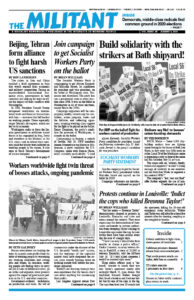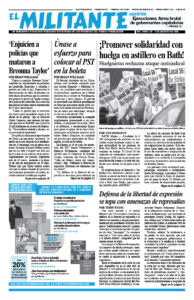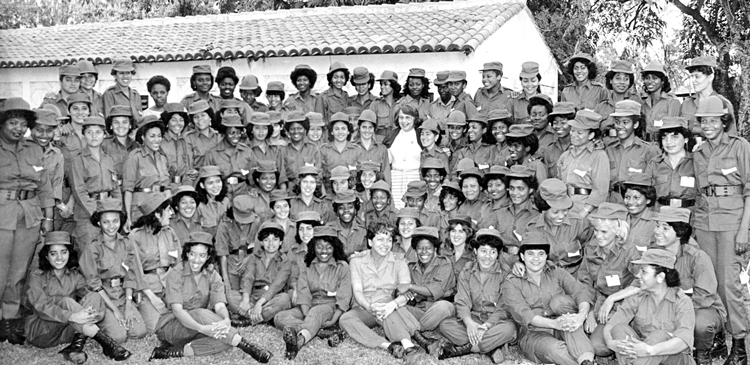Marianas in Combat: Teté Puebla and the Mariana Grajales Women’s Platoon in Cuba’s Revolutionary War, 1956-58 by Teté Puebla is one of Pathfinder’s Books of the Month for July. Puebla was an officer in the victorious Rebel Army and of its first all-women’s platoon, founded by Fidel Castro, the central leader of the Cuban Revolution. While helping to lead the fight to transform the social and economic status of women, she rose to become a brigadier general, the highest-ranking woman in Cuba’s Revolutionary Armed Forces. The book was edited by Mary-Alice Waters, who also wrote the introduction. Copyright © 2003 by Pathfinder Press. Reprinted by permission.
The first great effort was the literacy drive, which had its roots in the Rebel Army. There was a department for this in the armed forces.
In 1958 I helped Celia [Sánchez] organize elementary schools in the Sierra Maestra, since there were none there, and of course many children were illiterate. The big majority of peasant women were illiterate, and many rebel fighters too.
Cuba was the first in the world to eradicate illiteracy. Women were part of that struggle, young women especially. There was a massive incorporation of youth and children into the literacy effort, with boys and girls aged ten, eleven, and twelve teaching others, including adults, how to read and write. Women made up over half of the literacy volunteers. And, of course, illiteracy was greater among women than men. …
After the revolution, this changed. Women began to organize massively working to change the conditions of their lives and to free themselves. …
From the beginning, the Federation [of Cuban Women] worked to incorporate women into the struggle through bringing them into the work force. Because when a woman begins to work outside her home, she organizes her life and she develops. This happened in all stages of the revolution. And among women of all ages and in all occupations.
Before the triumph, many women used to come in from the countryside to work as servants in the homes of the rich. So the federation opened up schools for them. We established the Ana Betancourt schools here in Havana, named after a combatant from the independence war of 1868. Some of the mansions in Miramar, like those in which the women used to work, were turned into schools and dormitories for them.
In the Ana Betancourt schools the women learned to read and write; in addition, they were taught to sew and embroider. When their studies were over, and they graduated in cutting and sewing, Fidel ordered that each one be given a sewing machine to take home. The commitment was they would use it to teach someone else. You’d see these machines in peasants’ homes in the mountains and on the plains.
I was involved in helping to recruit the first campesinas for the Ana Betancourt School.
To get those peasant women to come, to get the men to agree wasn’t easy. A lot of machismo existed. Some men would say, “Not my daughter” or “Not my wife.” And we had to work hard to bring them into the revolutionary process, to convince the men why we had to teach sewing, that it would be a help to their families.
During the final years of the dictatorship there were also many prostitutes. They were brought into the revolution, too. They were given housing because many were from outside Havana and had no homes here. We built schools for them and found them jobs in workplaces.
An especially big effort was made toward women who had worked as prostitutes in Havana. It was true elsewhere too, but the largest concentration had been in Havana. Before the revolution, it was even considered a privilege for these women to prostitute themselves in Havana, because of the greater possibilities for getting out of the country.
These women had taken the road of prostitution because they couldn’t find work under capitalism. But the revolution changed that. The Federation of Cuban Women played a role in this, a very important one. …
In the Sierra Maestra the work of incorporating women into schools and jobs was easier. Because the peasants had seen us with them there from the beginning. It was harder in other places; you have to keep in mind the low cultural level of the peasants before the revolution, the isolation and lack of access to education.
These prejudices were still strong a full decade after the revolution’s victory.
In March 1969, on the order of the commander in chief, I was named director of the Guaicanamar Cattle Plan in Jaruco, in Havana province. He said he was putting me in charge to demonstrate that women could lead as well as men, to show that women could lead an agricultural project, that women could head up any front and carry out any task of the revolution. …
Women in Cuba have always been on the front line of the struggle. At Moncada we had Yeyé [Haydée Santamaría] and Melba [Hernández]. With the Granma and November 30, we had Celia, Vilma [Espín], and many other compañeras. There were many women comrades who were tortured and murdered.
From the beginning there were women in the Revolutionary Armed Forces. First they were simple soldiers, later sergeants. Those of us in the Mariana Grajales Platoon were the first officers. The ones who ended the war with officers’ ranks stayed in the armed forces.
Today there’s a women’s regiment in the Border Guard Battalion at the Guantánamo U.S. naval base in Caimanera, commanded by Lt. Col. Victoria Arrauz Caraballo, who was named by the minister of the armed forces to be second in command of the Border Guard Battalion that guards that territory. There are women in all the military units. They’re captains, majors, colonels. Women have also carried out internationalist missions. They went to Angola, to Ethiopia and elsewhere. By the time of the Angola mission, we had formed the Women’s Antiaircraft Artillery Defense Regiments. The members of the regiment assigned to Angola belonged to various combat units.


